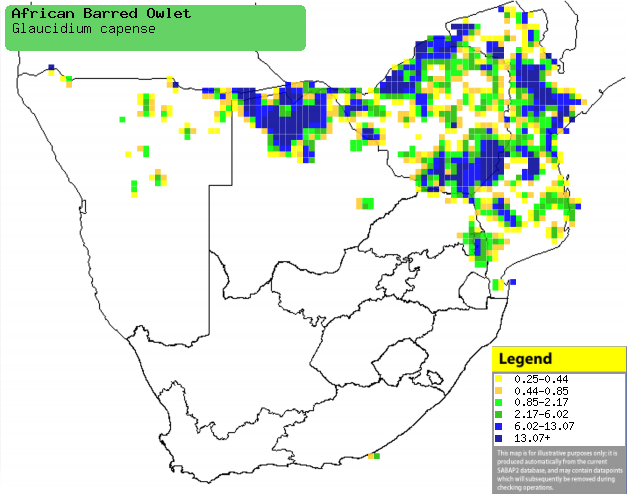|
Glaucidium capense (African
barred owlet, Barred owl)
Gebande uil [Afrikaans]; Kakuru (also applied to other owl
species) [Kwangali]; Zizi (generic name for owl) [Shona]; Lerubisana (applied to
a number of other owl species) [Tswana]; Kaapse dwerguil [Dutch]; Chevêchette
du Cap [French]; Kapkauz [German]; Mocho-barrado [Portuguese]
Life
> Eukaryotes >
Opisthokonta
> Metazoa (animals) >
Bilateria >
Deuterostomia > Chordata >
Craniata > Vertebrata (vertebrates) > Gnathostomata (jawed
vertebrates) > Teleostomi (teleost fish) > Osteichthyes (bony fish) > Class:
Sarcopterygii (lobe-finned
fish) > Stegocephalia (terrestrial
vertebrates) > Tetrapoda
(four-legged vertebrates) > Reptiliomorpha > Amniota >
Reptilia (reptiles) >
Romeriida > Diapsida > Archosauromorpha > Archosauria >
Dinosauria
(dinosaurs) > Saurischia > Theropoda (bipedal predatory dinosaurs) >
Coelurosauria > Maniraptora > Aves
(birds) >
Order: Strigiformes
> Family: Strigidae
The African barred owlet is uncommon in most areas of its
range, but is locally common in the Miombo woodlands of Zimbabwe, and northern
Botswana. It prefers open woodland, with sparse undergrowth and a stream or
river nearby. It eats mainly invertebrates, due to its small size, but it can
eat dormice, small birds and reptiles. It nests in natural tree hollows, up to
six metres above ground, laying 2-3 eggs, which are presumed to be
incubated by the female. The chicks stay in the nest 32-33 days, after which
they learn to fly. They usually can fly at 42 days old.
Distribution and habitat
Occurs from southern Kenya and Tanzania to southern DRC,
Angola, Zambia and southern Africa. Within southern it is locally common in
north-eastern Namibia, northern Botswana, Zimbabwe, Mozambique and north-eastern
South Africa. It generally prefers woodland with sparse undergrowth, especially
miombo (Brachystegia) woodland,
usually with a river or stream nearby. There have been some sightings in the
Eastern Cape, but they are seldom seen and they have are no signs of
breeding activities.
|
 |
|
Distribution of African barred owlet in southern Africa,
based on statistical smoothing of the records from first SA Bird Atlas
Project (©
Animal Demography unit, University of
Cape Town; smoothing by Birgit Erni and Francesca Little). Colours range
from dark blue (most common) through to yellow (least common).
See here for the latest distribution
from the SABAP2. |
Food
It mainly feeds on invertebrates, supplemented with birds, small mammals and reptiles. The following prey items
have been recorded in its diet:
- Invertebrates
- Vertebrates
- birds
- mammals
- reptiles
- amphibians
Breeding
- It usually nests in tree hollows, which can be up to about 6 metres above
ground. It sometimes visit the nest
by day, carrying feathers and leaves, which are presumed to be lining for
the nest.
- It lays 2-3 eggs in the period from August-October.
- Incubation is presumed to be done solely by the female for 28-34 days.
It can be extremely stubborn about not leaving the nest, so much so that
one can stroke and touch it without protest.
- The chicks are brooded for 14 days by the female, after which both sexes
hunt. The chicks are sometimes fed as many as 40 meals in six hours by both
parents. The brood leave the nest after 32-33 days, after which they live in
the vicinity of the nest. At about 42 days old, they learn to fly and become
fully independent.
Threats
Locally threatened in the Eastern Cape, where the
subspecies G. c. capense occurs. This subspecies used to occur in
KwaZulu-Natal, but since retreated to isolated areas in the Eastern cape.
References
-
Hockey PAR, Dean WRJ and Ryan PG (eds) 2005. Roberts
- Birds of southern Africa, VIIth ed. The Trustees of the John Voelcker
Bird Book Fund, Cape Town.
|
